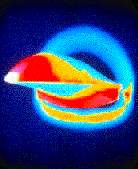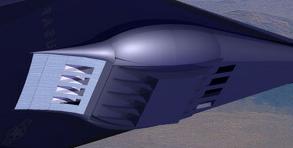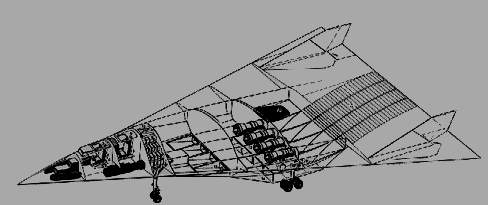|
Does the United States Air Force or one of America's intelligence agencies have a secret hypersonic aircraft capable of a Mach 6 performance? Continually growing evidence suggests that the answer to this question is yes. Perhaps the most well-known event which provides evidence of such a craft's existence is the sighting of a triangular plane over the North Sea in August 1989 by oil-exploration engineer Chris Gibson. As well as the famous "skyquakes" heard over Los Angeles since the early 1990s, found to be heading for the secret Groom Lake installation in the Nevada desert, numerous other facts provide an understanding of how the aircraft's technology works. Rumored to exist but routinely denied by U.S. officials, the name of this aircraft is Aurora. |
|
The outside world uses the name Aurora because a censor's slip let it appear below the SR-71 Blackbird and U-2 in the 1985 Pentagon budget request. Even if this was the actual name of the project, it would have by now been changed after being compromised in such a manner.
The plane's real name has been kept a secret along with its existence. This is not unfamiliar though, the F-117a stealth fighter was kept a secret for over ten years after its first pre-production test flight. The project is what is technically known as a Special Access Program (SAP). More often, such projects are referred to as "black programs".
So what was the first sign of the existence of such an aircraft? On 6 March 1990, one of the United States Air Force's Lockheed SR-71 Blackbird spyplanes shattered the official air speed record from Los Angeles to Washington's Dulles Airport. There, a brief ceremony marked the end of the SR-71's operational career. Officially, the SR-71 was being retired to save the $200-$300 million a year it cost to operate the fleet. Some reporters were told the plane had been made redundant by sophisticated spy satellites.
But there was one problem, the USAF made no opposition towards the plane's retirement, and congressional attempts to revive the program were discouraged. Never in the history of the USAF had a program been closed without opposition. Aurora is the missing factor to the silent closure of the SR-71 program.
Testing such a new radical aircraft brings immense costs and inconvenience, not just in the design and development of a prototype aircraft, but also in providing a secret testing place for aircraft that are obviously different from those the public are aware of.
Groom Dry Lake, in the Nevada desert, is home to one of America's elite secret proving grounds. Here is Aurora's most likely test location. Comparing today's Groom Lake with images of the base in the 1970s, it is apparent that many of the larger buildings and hangars were added during the following decade. Also, the Groom Lake test facility has a lake-bed runway that is six miles long, twice as long as the longest normal runways in the United States. The reason for such a long runway is simple: the length of a runway is determined either by the distance an aircraft requires to accelerate to flying speed, or the distance that the aircraft needs to decelerate after landing. That distance is proportional to the speed at which lift-off takes place. Usually, very long runways are designed for aircraft with very high minimum flying speeds, and, as is the case at Edwards AFB, these are aircraft that are optimized for very high maximum speeds. Almost 19,000 feet of the runway at Groom Lake is paved for normal operations.
Lockheed's Skunk Works, now the Lockheed Advanced Development Company, is the most likely prime contractor for the Aurora aircraft. Throughout the 1980s, financial analysts concluded that Lockheed had been engaged in several large classified projects. However, they weren't able to identify enough of them to account for the company's income.
Technically, the Skunk Works has a unique record of managing large, high-risk programs under an incredible unparalleled secrecy. Even with high-risk projects the company has undertaken, Lockheed has a record of providing what it promises to deliver.
By 1945, only a small amount of jets had the capability of reaching speeds of 500mph. In 1960, aircraft that could exceed 1,500mph were going into squadron service. Aircraft capable of 2,000mph were under development and supposed to enter service by 1965. This was a four-fold increase in speed in two decades.
From this, the next logical step was to achieve hypersonic speed. The definition of hypersonic isn't as clearly defined as supersonic, but aerodynamicists consider that the hypersonic realm starts when the air in front of the vehicle's leading edges "stagnates": a band of air is trapped, unable to flow around the vehicle, and reaches extremely high pressures and temperatures. The edge of the hypersonic regime lies at a speed of roughly one mile per second - 3,600mph or Mach 5.4.
What is regarded by many as the most successful experimental aircraft program in USAF history, the X-15 rocketplane was created in response to a requirement issued by NASA (then NACA) for an air-launched manned research vehicle with a maximum speed of more than Mach 6 and a maximum altitude of more than fifty miles.
The X-15 program, which involved three test aircraft, went on to exceed all goals set and provided valuable data which has been used on many high speed/altitude aircraft of today, including NASA spacecraft, and most likely, the Aurora aircraft.
In the early 1960s, Lockheed and the USAF Flight Dynamics Laboratory began a hypersonic research program which would provide data on travel at hypersonic speed as well as more efficient shapes for hypersonic vehicles. From this program came the FDL-5 research vehicle, which beared an amazing resemblance to the North Sea Aurora sighting of Chris Gibson. Building on both the FDL-5 Project and Aurora, the aircraft which may have been seen over the North Sea could have been Northrop's A-17 stealth attack plane.
Possible forms of hypersonic propulsion that Aurora could be using include:
There are three reasons why the North Sea sketch drawn by Chris Gibson is the most persuasive rendition of the Aurora vehicle. Firstly, the observer's qualifications, with which he couldn't identify the aircraft; which would have been instantaneous if the aircraft was known to the "white world". Second is the fact that the North Sea aircraft corresponds almost perfectly in shape and size to hypersonic aircraft studies carried out by McDonnell Douglas and the USAF during the 1970s and 1980s. The third factor is that the North Sea aircraft looks unlike anything else. No aircraft other than a high-supersonic vehicle, or a test aircraft for such a vehicle, has ever been built or studied with a similiar planform.
At hypersonic speeds, traditional aerodynamic design gives way to aero-thermodynamic design. In order for a hypersonic vehicle to remain structurally intact at such high speeds and stresses, the vehicle must produce minimum drag and be free of design features that give rise to concentrations of heat. The aircraft design must be able to spread the heat over the surface of the structure.
Thermal management is critical to high-speed aircraft, especially hypersonic vehicles. Skin friction releases heat energy into the aircraft and must be pumped out again if the vehicle is to have any endurance. The only way to do this is to heat the fuel before it enters the engine, and dump the heat through the exhaust. On a hypersonic vehicle, thermal management is very critical, the cooling capacity of the fuel must be used carefully and efficiently or else the range and endurance of the aircraft will be limited by heating rather than the actual fuel tank capacity.

|
So how will an aircraft reach such speeds? Conventional turbojet engines won't be able to handle the incoming airstreams at such speeds, they can barely handle transonic speeds. In the case of hypersonic propulsion, an aero-thermodynamic duct, or ramjet, is the only engine proven to work efficiently at such speeds. Even ramjets have drawbacks though, such as drag created in the process of slowing down and compressing a Mach 6 airstream.
To make a ramjet engine efficient is to spread the air over the entire length of the body. In a hypersonic ramjet aircraft, the entire underside of the forward body acts as a ramp that compresses the air, and the entire underside of the tail is an exhaust nozzle. So much air underneath the aircraft serves another purpose, it keeps the plane up.
The ramjets need a large inlet area to provide the high thrust needed for Mach 6 cruise. As a result, the engines occupy a large area beneath vehicle and the need to accomodate a large quantity of fuel means that an all-body shape is most feasible.

|
Structurally, the all-body shape is highly efficient. As well as being extremely aerodynamic, the average cross-sectional area being very large provides a great deal of space for load, equipment and fuel. This being inside a structure that is light and compact having a relatively small surface area to generate frictional drag.
The spyplane's airframe may incorporate stealth technology, but it doesn't really require it should its mission simply involve high altitude reconnaissance. Hypersonic aircraft are much harder to shoot down than a ballistic missile. Although a hypersonic plane isn't very maneuverable, its velocity is such that even a small turn puts it miles away from a SAM's projected interception point.

|
Choosing the right type of fuel is crucial to the success of Aurora. Because various sections of the craft will reach cruising-speed temperatures ranging from 1,000 degrees fahrenheitto more than 1,400 degrees fahrenheit, its fuel must both provide energy for the engines and act as a structural coolant extracting destructive heat from the plane's surface.
At hypersonic speeds, even exotic kerosene such as the special high-flashpoint JP-7 fuel used by the SR-71 Blackbird can't absorb enough heat. The plausible solution is cryogenic fuel.
The best possibilities are methane and hydrogen. Liquid hydrogen provides more than three times as much energy and absorbs six times more heat per pound than any other fuel. The downfall is its low density, which means larger fuel tanks, a larger airframe and more drag. While liquid hydrogen is the fuel of choice for spacelaunch vehicles that accelerate quickly out of the atmosphere, studies have shown that liquid methane is better for an aircraft cruising at Mach 5 to Mach 7. Methane is widely available, provides more energy than jet fuels, and can absorb five times as much heat as kerosene. Compared with liquid hydrogen, it is three times denser and easier to handle.
On 16 November 1998, a camcorder video was taken of a mysterious "fireball" in the sky. While this was very interesting, what was even more amazing was the aircraft which was seen shortly after flying at very high speed producing the mysterious "donuts-on-a-rope" contrails. Does this video, which is currently undergoing intense study at JPL, show the mysterious Aurora spyplane?
A newspaper article about this event was also written in the The Sun Herald newspaper.
The following message was sent by e-mail from the person who recorded it.
From: RINGDINGGG@aol.com Date: Fri, 25 Dec 1998 06:53:30 EST To: c0d@bigfoot.com Subject: FIREBALL/Meteor Shower ? Missile object Video 11/16/98 Florida I shot this video during the meteor showers over the Gulf of Mexico from my home in Port Charlotte, FL. I think is very interesting and It has found its way to National TV News Magazine EXTRA which aired the video FIREBALL story on 12/23/98 It is being analyzed frame by frame at the JPL. One thing they will find for sure is that this video is real; but what the objects are I cant say. Hope you enjoy the footage and Merry Christmas from Jim DeVoy
(Webauthor note: Video not online anymore)
See also this Press article.